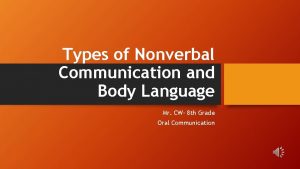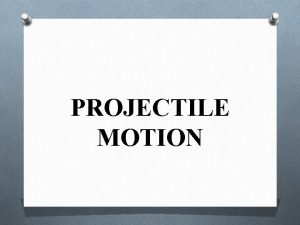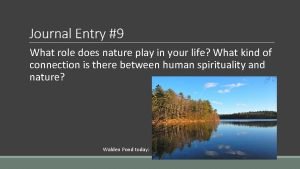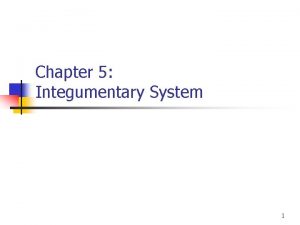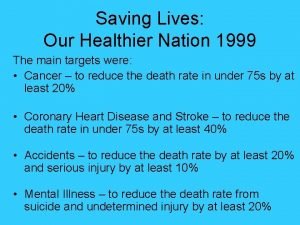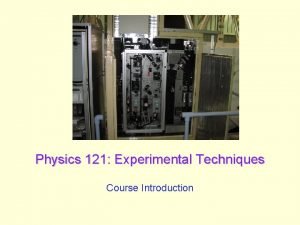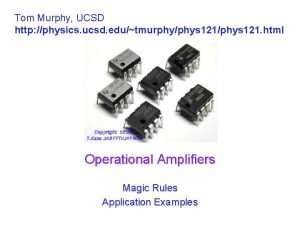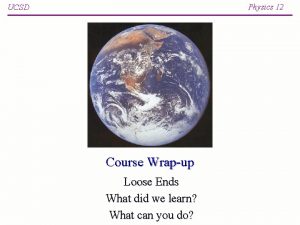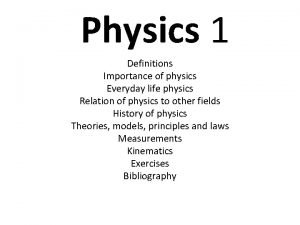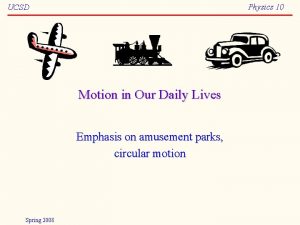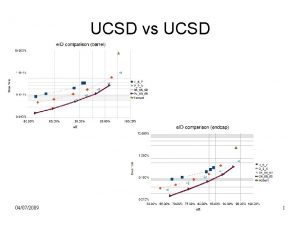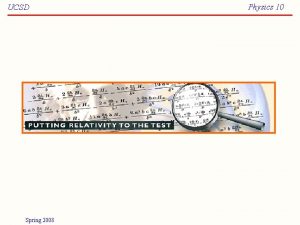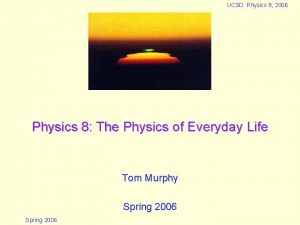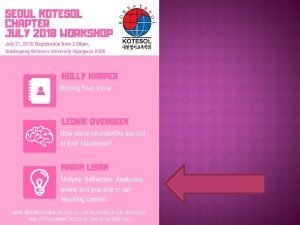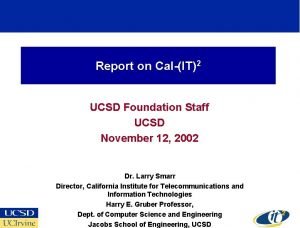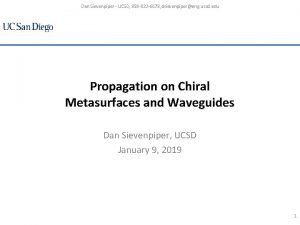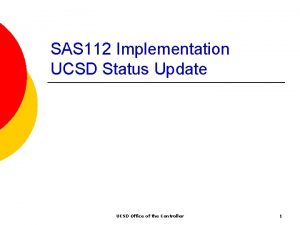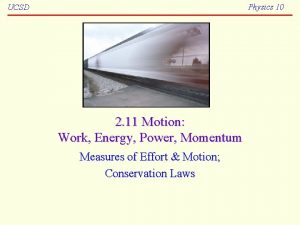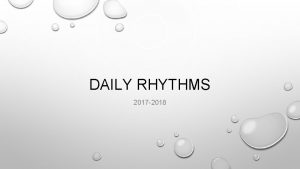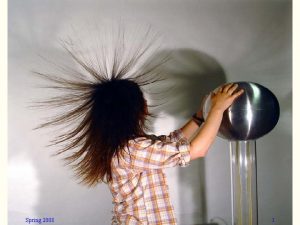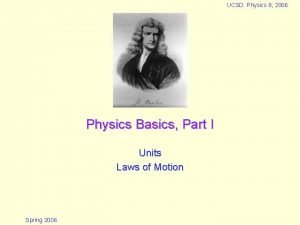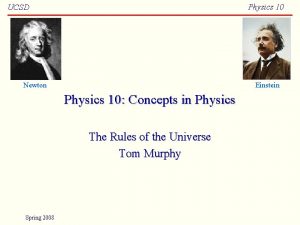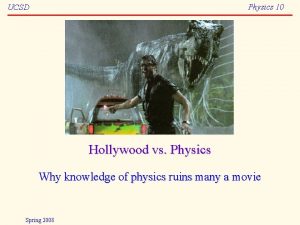Physics 10 UCSD Motion in Our Daily Lives




















- Slides: 20

Physics 10 UCSD Motion in Our Daily Lives Emphasis on amusement parks, circular motion Spring 2008

Physics 10 UCSD What kind of motions do we feel? • Aside from vibrations, don’t feel constant velocity – Earth moves 30, 000 m/s around sun • only curves 3 mm toward sun each second, so compared to the 30, 000 meters, you could say that our path is almost straight • But we can feel acceleration – It’s that “visceral” feeling… – vis·cer·al adj. 1. Relating to, situated in, or affecting the viscera. 2. Perceived in or as if in the viscera. – vis·cer·a pl. n. 1. The soft internal organs of the body, especially those contained within the abdominal and thoracic cavities. 2. The intestines. [3. Your gut. ] Spring 2008 2

Physics 10 UCSD Questions: • Why do we feel acceleration? What is it about our gut that tells us we’re moving? What other organs in our body tell us we are accelerating? – Think in terms of amusement park rides, where acceleration is extreme (or like how my sister drives). • Can you feel gravity when you’re sitting still? Standing? Laying down? Falling? Spring 2008 3

Physics 10 UCSD Motion in our lives • We’ll ignore constant velocity: just like sitting still – boring • But accelerating motion… – that’s where things get interesting • Direction of acceleration is the same as the direction of net force • Acceleration perpendicular to the velocity vector acts to change the direction of motion. Spring 2008 4

Physics 10 UCSD The Amusement Park: Acceleration Central • Zero-g (no acceleration) motion – Free-fall, cresting roller coaster • Linear acceleration – log flume deceleration, roller coaster abrupt stop • Directional changes (bread & butter of parks) – Curves of roller coaster, tilt-a-whirl, swings – Loops, crests, troughs of roller coasters – Spinning drum (pinned against wall) Spring 2008 5

Physics 10 UCSD Free fall • By dropping a carriage, or by launching a car on a parabolic path, experience momentary zero-g • You are accelerating downwards toward the earth, but no longer feel accelerated: don’t feel weight – only lasts a brief moment: 15 -story (45 m) drop only lasts about 3 seconds NASA conducts zero-g flights lasting 30 seconds by flying a parabolic path in a plane that has come to be known as the “vomit comet”. www. avweb. com/articles/vcomet/ Spring 2008 6

Physics 10 UCSD Linear Acceleration (in velocity direction) • This is the familiar stoplight acceleration along a straight line • Zero to Sixty-Seven (30 m/s) in 5 seconds: – 30 m/s in 5 seconds means 6 m/s 2 (~0. 6 g) • Typical car acceleration, normal driving ~0. 2 g • Fun activity: drive with helium balloons in car – They move into acceleration--counter-intuitive – They simply point the way a plumb bob hung from the rear-view mirror doesn’t Spring 2008 7

Physics 10 UCSD Questions: • During which part of a roller coaster ride do you feel heaviest: at the bottom of a dip or at the crest of a hill? Where do you feel the lightest? • If you’re in an elevator with an upward/downward acceleration rate of 1 m/s 2 and you normally weigh 100 pounds, how much will you weigh when the elevator accelerates upwards? Downwards? – Assume gravity is 10 m/s 2 for numerical simplicity Spring 2008 8

Physics 10 UCSD Curves, Centrifugal, Centripetal Forces • Going around a curve smushes you against window – Understand this as inertia: you want to go straight your body wants to keep going straight but the car is accelerating towards the center of the curve Car acceleration is v 2/r you think you’re being accelerated by v 2/r relative to the car Spring 2008 9

Physics 10 UCSD Centripetal, Centrifugal Forces, continued • The car is accelerated toward the center of the curve by a centripetal (center seeking) force • In your reference frame of the car, you experience a “fake”, or fictitious centrifugal “force” – Not a real force, just inertia relative to car’s acceleration Centripetal Force on car Spring 2008 velocity of car (and the way you’d rather go) 10

Physics 10 UCSD Pictorial “Derivation” of Centripetal Acceleration Top view: a a a = v 2/r (r is radius of curve) Spring 2008 a = Dv/Dt v 2 v 1 In uniform circular motion the acceleration is constant, directed towards the center. The velocity has constant magnitude, and is tangent to the path. 11

Physics 10 UCSD Rotating Drum Ride • Vertical drum rotates, you’re pressed against wall – Friction force against wall matches gravity – Seem to stick to wall, feel very heavy The forces real and perceived Real Forces: Friction; up Centripetal; inwards Gravity (weight); down Perceived Forces: Centrifugal; outwards Gravity (weight); down Perceived weight; down and out Spring 2008 12

Physics 10 UCSD Works in vertical direction too… • Roller coaster loops: – Loop accelerates you downward (at top) with acceleration greater than gravity – You are “pulled” into the floor, train stays on track • it’s actually the train being pulled into you! Spring 2008 13

Physics 10 UCSD Sustained vertical spinning • Ever wonder what a bike tire feels like? • At constant speed, the centripetal acceleration is constant (v 2/r), but the direction of gravity keeps changing! • Feel heavier at bottom than at top • This ride definitely turns your world around! Spring 2008 14

Physics 10 UCSD Old-Fashioned Swings • The angle of the ropes tells us where the forces are: • Ropes and gravity pull on swingers • If no vertical motions (level swing), vertical forces cancel • Only thing left is horizontal component pointing toward center: centripetal force • Centripetal force is just mv 2/r (F = ma; a = v 2/r) swing ropes: what you feel from your seat gravity (mg) Spring 2008 resultant: centripetal 15

Physics 10 UCSD Airplanes in high-g turn • Airplanes don’t have “rubber on the road”, so no friction to keep them from going sideways around turns • Wings produce lift force, so proper bank angle supplies necessary horizontal component of force to produce turn enhanced lift during turn: vertical component cancels gravity to produce level flight, horizontal component affects turn Spring 2008 Pilot accelerated by orange (lift) vector, feels heavier than normal. gravity In this case, pilot feels about 3 g’s (orange arrow about 3 times longer than gravity arrow) 16

Physics 10 UCSD What about our circular motions on Earth? • Earth revolves on its axis once per day • Earth moves in (roughly) a circle about the sun • What are the accelerations produced by these motions, and why don’t we feel them? Spring 2008 17

Physics 10 UCSD Earth Rotation • Velocity at equator: 2 r / (86, 400 sec) = 463 m/s • v 2/r = 0. 034 m/s 2 – ~300 times weaker than gravity, which is 9. 8 m/s 2 • • • Makes you feel lighter by 0. 3% than if not rotating No rotation at north pole no reduction in g If you weigh 150 pounds at north pole, you’ll weigh 149. 5 pounds at the equator – actually, effect is even more pronounced than this (by another half-pound) owing to stronger gravity at pole: earth’s oblate shape is the reason for this Spring 2008 18

Physics 10 UCSD Earth Orbit • The earth is also traveling in an orbit around the sun – v = 30, 000 m/s, r = 1. 5 1011 m v 2/r = 0. 006 m/s 2 – but gravitational acceleration on our bodies from the sun is exactly this same amount. • in other words, the acceleration that makes the earth accelerate in a circular orbit also acts on us directly, causing us to want to follow the same path as earth • this is to be contrasted with the car going around a curve, in which friction between pavement and tires applies a force on the car, but not on us directly, causing us to want to go straight – another way to say this: we are in free-fall around the sun Spring 2008 19

Physics 10 UCSD Assignments • HW for 5/09 has problems relevant for exam: Hewitt 7. E. 42, 7. P. 9, 6. R. 16, 6. R. 19, 6. R. 22, 6. R. 23, 6. E. 8, 6. E. 12, 6. E. 43, 6. P. 6, 6. P. 12, 8. R. 29, 8. E. 47, 8. P. 9 – may benefit you to look at them early, or even do them • • • Review Session TBA Exam mostly MC/TF, some short answer Need: – – scantron (light green; form # X-101864 -PARL) No. 2 pencil calculator of any type sit with one empty seat between yourself and nearest neighbor Spring 2008 20
 Energy in our daily lives
Energy in our daily lives Eye contact is woven into the fabric of our daily lives.
Eye contact is woven into the fabric of our daily lives. What are two components of projectile motion
What are two components of projectile motion The mass media play an important
The mass media play an important Drawing on the power of jesus christ nelson
Drawing on the power of jesus christ nelson 6 word memoirs about sports
6 word memoirs about sports Tissue poem context
Tissue poem context Nature journal entry
Nature journal entry During our lives, we produce three kinds of hair:
During our lives, we produce three kinds of hair: God's work in our lives
God's work in our lives Our healthier nation (1999)
Our healthier nation (1999) Physics courses ucsd
Physics courses ucsd Serf ucsd
Serf ucsd Ucsd physics
Ucsd physics Ucsd physics courses
Ucsd physics courses Role of information technology in our daily life
Role of information technology in our daily life Polynomials real life problems
Polynomials real life problems A useful tool for making healthful daily food choices
A useful tool for making healthful daily food choices Poem catalyst
Poem catalyst 3 importance of physics in daily life
3 importance of physics in daily life Thinking affects our language which then affects our
Thinking affects our language which then affects our

